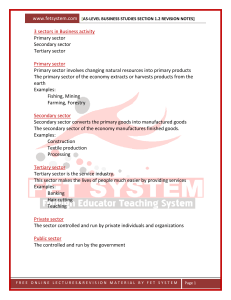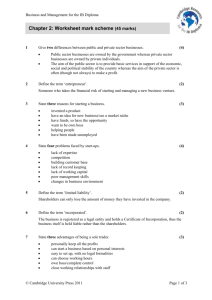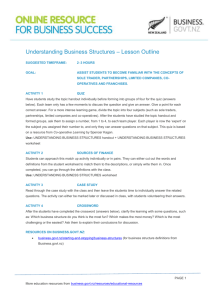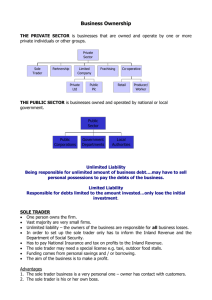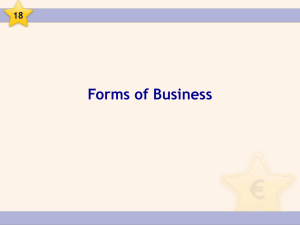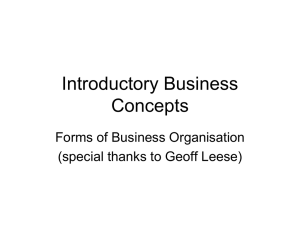File
advertisement
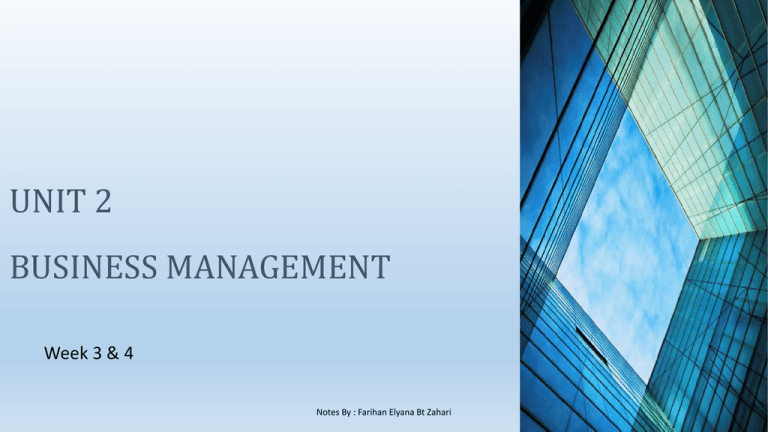
UNIT 2 BUSINESS MANAGEMENT Week 3 & 4 Notes By : Farihan Elyana Bt Zahari LESSON LEARNING OUTCOME: 1. Explain the management function. 2. Propose the formation of new business Notes By : Farihan Elyana Bt Zahari Management: Definitions “Management is the process of designing and maintaining an environment in which individuals, working together in groups, efficiently accomplish selected aim(s) viz. to create a surplus(s).” …. Weihrich & Koontz “Management is not an absolute; rather it is socially and culturally determined. Across all cultures and in all societies, people coming together to perform certain collective acts encounter common problems having to do with establishing direction, coordination and motivation. Culture affects how these problems are perceived and resolved.” …The Art of Japanese Management by R. Pascale & A. Athos . vikramthadeshvar@hotmail.com SYSTEMS APPROACH TO MANAGEMENT Management as a system transforms inputs: by the process of Planning + Organizing + Leading + Controlling Planning involves selecting objectives or goals and the course of actions to achieve them: Provides the bridge to take us from where we are to where we want to go; Is a rational approach to achieving pre-selected objectives - based on innovation, knowledge and purpose; Decision making in choosing the best from alternative courses of action and is integral to planning; Notes By : Farihan Elyana Bt Zahari Plans as foundation of Management What kind of resources needed? What kind of people & org. structure to have? Plans How to lead them to reach planned goals? How to control in case of deviation from plan ? vikramthadeshvar@hotmail.com The primacy of Planning Types of Plans • Mission / Purpose – The basic function or ‘reason for existence’ of an enterprise/ organization Case in point: Mission of Politeknik Tuanku Syed Sirajuddin “Mewujudkan ekosistem pembelajaran yang transformatif, kondusif dan inovatif.” Type of Plans (Cont’d) • Objectives/ Goals – The end towards which activity of an organization is aimed, e.g. • • • For a Business enterprise – profit, surplus creation; For a Management Institute: The number of employable/useful trainees; Strategies – – Determination of the long term objectives and adoption of a course of action Gives a frame work for linked action-plans, communicated systematically to guide thinking and actions. Types of Plans (cont’d) • Policies – “Plans” that are general directional statements (or understandings) that guide/help in decision making: • • – – Repeat decisions taken ‘reflexively’; Delegation of tasks without loss of control. Some discretion is permissible depending on circumstances thus encouraging initiative within limits and situational adjustments; Issues with “Policy” • • Seldom documented in writing Subject to interpretations Types of Plans (cont’d) • Procedures Plans that are chronological sequences of required actions: task-oriented in nature; – Cuts across department boundaries (sub-systems) in an organization: e.g. customer complaint handling procedure; – Procedures and policies are inter related: e.g. authorization for paid leave – • • • Policy governs quota, responsible authority etc. Procedure governs application, grant and record-keeping. Rules – Specific actions or non-actions allowing no discretion • Caution: rules (and procedures too) limit initiative! Types of Plans (cont’d) • Programs – Action plans (mainly non-routine or for changed activities) including, task assignments, steps to be taken, resources to be deployed etc. to achieve a (new/renewed) goal; • • – Primary program may require supporting programs, spreading across the enterprise; Perfect coordination between supporting & primary programs essential to avoid delays, unnecessary costs and expected roll-out. Programs are a complex of (sub)goals, policies, rules and other elements necessary for the course of action e.g. obtaining ISO certification. Types of Plans (cont’d) • Budgets – – A statement of expected results expressed in “Numerical terms” e.g. financial operating budget = “profit plan”; Budgets enforce precision in thinking: • • – Making a budget is ‘planning’ by itself; Encourages innovation – a “different” way to work Budgets serve for ‘Control’: • • • Enforces discipline in execution of plans; Instills cost consciousness; Makes people (constantly) plan! Steps in Planning Being aware of challenges Market, Customer’s wants, Competition, Own strengths & weakness Setting Goals/ Objectives Planning premises What to accomplish & when Budgeting (Numberizing Plans) e.g., Sales budget Operational Expense budget, Capital expenditure budget Identifying alternatives Internal & external Environment/conditions Formulating Supporting plans Comparing & choosing an alternative e.g., plan to buy Decision Equipment, recruit & train making Employees, develop product etc Nature of Organizing Organizing may be broadly defined as: • 1. 2. 3. 4. The identification and classification of required activities; The grouping of those activities towards attaining their set objectives; The assignment of those groupings to a responsible manager, duly empowered; The provision for coordination among, within and across the groups in the organization. Organization structures are designed to: • – – – – Clarify tasks & responsibilities, Remove obstacles, Furnish decision making & communication network Support attainment of enterprise objectives Leading • involves the social and informal sources of influence that you use to inspire action taken by others. If managers are effective leaders, their subordinates will be enthusiastic about exerting effort to attain organizational objectives. Notes By : Farihan Elyana Bt Zahari Controlling • involves ensuring that performance does not deviate from standards. • Controlling consists of three steps, which include i. ii. iii. establishing performance standards, comparing actual performance against standards, taking corrective action when necessary. • The measurement of performance can be done in several ways, depending on the performance standards, including financial statements, sales reports, production results, customer satisfaction, and formal performance appraisals. • Effective controlling requires the existence of plans, since planning provides the necessary performance standards or objectives. • Controlling also requires a clear understanding of where responsibility for deviations from standards lies. Two traditional control techniques are budget and performance audits. An audit involves an examination and verification of records and supporting documents. Notes By : Farihan Elyana Bt Zahari Types of Business Ownership Private Sector • Sole Trader • Partnerships • Private Limited Company (Ltd) • Public Limited Company (plc) • Franchise Public Sector • Public Corporations • Municipal Undertakings • Trusts Sole Trader Key Features A Sole Trader has: • 1 owner • 0 to any number of employees A Sole Trader is in the Private Sector Sole Trader Disadvantages Advantages • Unlimited liability • No one to share decision making • Lack of specialisation • No continuity of existence • Time off/holidays • Limited finance Sole Proprietorship/Sole Trader • Formed under the Business Act 1956 – – – This type of business is owned by an individual or sole person. Has a simple business structure Some sole trader can operate as big business, e.g. Family run business. • – E.g. Kamdar Departmental Store was sole trader for long time until it turn into private limited company ( Sdn. Bhd.) Example of Sole trader – tailor, Beauty Saloon, restaurants, launderettes (dobi), mini market etc. Advantage Sole Proprietorship • Easy to manage the business. • All decision made by the owner- manager. • Low start up capital, no heavy investment. • Flexibility in operation. • The Sole trader can act quickly with a degree of flexibility. • Own boss • Total control • Greater opportunity for flexible working • Keep all profits • Easy to set up – few legal requirements • Easy to form and dissolve (bubarkan) with minimum formalities. • Nobody shares the rewards of the business, all profit will go to the owner. • Subject to less government rules and regulation. • The owner – manager has to pay income tax based on total profit earned to LHDN ( Inland Revenue Board, M’sia) Disadvantages Sole Proprietorship – Limited source of capital • – The liability is unlimited • – Lack of capital to expand the business further. The owner- manager will be liable to settle all debts outstanding. Failing which all assets will be ceased by court order to be sold, and cash generated will used to pay all outstanding creditors. The future development of the business is limited. • Lot depends on the managerial capability of the owner and physical health. The life span of the business depends upon the age of the owner and how efficiently he manages the business. – He is of ill health or passes away the business continuation is disrupted. – If he choose an heir (successor) to the business, then the business has to be reregistered. – Partnership A Partnership can have: • 2 - 20 owners • 0 to any number of employees • A Sleeping Partner - someone who invests money but takes no part in the day to day running • A Deed of Partnership - lays out rules for running and dissolution of the Partnership eg sharing of profits A Partnership is in the Private Sector • Partnership is a legal business entity with two or more partners. • In this type of business, a person forms a partnership (kongsian) • A partnership business has to be registered under the Business Registration Act 1956 Partnership – Advantages • Easy to set up and operate – less formalities. • Easier to secure financial assistance from financial institutions. • Equity can be increased from existing partners. • Business risks can be less because risk is borne by all existing partners. • The responsibility of managing and overseeing the business can be handled by all partners. • Ideas, talents and skills can be pooled together from partners for better management. • Income tax is not imposed on the partnership business but instead on the individual partners. • Shared decision making • Increased capital invested • Increased specialisation • Easy to set up – few legal requirements Partnership – Advantages & Disadvantages • Business liabilities are unlimited. – Personal assets can be seized by court order since no distinction between personal & business assets. • The life span (jangka hayat) of the partnership business depends on the life spans of the business. • If partner declared bankrupt, dies or become insane business has to be dissolved. • If a Letter of Agreement as per Partnership Act 1961 is not made members may resort to mismanage or be unethical in conducting their business in the partnership. • Difference of opinion and conflict may lead to breakup of the partnership. • Unlimited liability • Profits have to be shared between partners • No continuity of existence • Partners may have disagreements • Limited finance Contract Agreement • It is necessary for the business to have some kind of Contract or Partnership Agreement to minimize any problems that may arise. • The Business Registration Act 1956 does not state that the formation of a partnership business must have a written agreement. Contract Agreement • Should an agreement arises what should be the contents? – The Contents are as follows: • Name of the business • The duration of the partnership • Agreement as the partnership status once the partner/s passes away or withdraws from the partnership. • The name of the individuals involved in managing the partnership. • The accounts of the business. • The structure of ownership i.e. the contribution made by individual partners. • The rights and obligation of the business partners • What are the properties that are considered as business assets to distinguish from personal assets. Partnership Act 1961 • According to Sect 26 & 27 of the above act: – – – – – Profit & Loss are to be shared equally. No interest is payable on a partner’s capital Partners are required to participate actively in the business. No partner is entitled for salary for work contribution done for the partnership. Partner’s should be paid based on their contribution. Partnership Act 1961 – – – – – Daily routine matters can be decided by the majority of the partners, but major changes require the support of all partners. Partner may choose not to be partner any longer if all partners have agreed. If all partners agree a new partner can be brought to replace the old partner. All business accounts books need to ket in the business premises. Partners have the right to check the books of the company as when needed. Private Limited Company (Ltd) A Private Limited Company has the following key features: • Ltd after it’s name • Owners called shareholders • A separate legal existence from owners • Shareholders who are family and friends • Governed by two legal documents: – Memorandum of Association – Articles of Association • Controlled by a Board of Directors • Run by a Managing Director A Private Limited Company is in the Private Sector Private Limited Company (Ltd) Advantages • Limited liability • Greater availability of finance • Specialisation can occur Disadvantages • More complicated to set up - legal formalities • Loss of individual control Public Limited Company (plc) A Public Limited Company has the following key features: • plc after it’s name • Owners called shareholders • A separate legal existence from owners • Shareholders who are members of the general public • Governed by two legal documents: – Memorandum of Association – Articles of Association • Controlled by a Board of Directors • Run by a Managing Director A Public Limited Company is in the Private Sector Public Limited Company (plc) Disadvantages Advantages • Limited liability • • Greater availability of finance More complicated to set up - legal formalities • Loss of individual control • Greater threat of takeover • Specialisation can occur Franchise Key A Franchise is: • Where a business (the Franchiser) allows another business (Franchisee) to trade under their name • Also a method of business growth • Some examples of franchises: – – – – • McDonalds Pizza Hut Kwik Fit Thorntons Also going to have another type of business ownership eg sole trader etc A Franchise is in the Private Sector Franchising Disadvantages Advantages For Franchisee • Established name • Support of Franchiser For Franchiser • Quick way to grow • Royalties from Franchisee For Franchisee • Lack of total control For Franchiser • Risk of reputation from unsuitable franchisee Comparison Business Ownership FEATURES SOLE TRADER PARTNERSHIP LTD PLC FRANCHISE Number of owners: 1 2 - 20 Unlimited number of shareholders Unlimited number of shareholders Franchisor owns the name. Franchisee owns the premises Liability of owners: Unlimited Unlimited sleeping partner - limited liability Limited Limited Depends on set up - may be a sole trader, Ltd Capital provided Owner Partners Shareholders Shareholders Franchisee Who gets profits? Owner Partners – may be split according to amount invested Shareholders Shareholders Franchisee Franchisor paid royalties - % of profits Risks: High High Low Low Low Legal Requirements: None None Registration under Companies Act Memorandum and Articles of Association. Then receive a Certificate of Incorporation PLC also receives Certificate of Trading Depends on set up of business (eg sole trader set up – no legal requirements etc) Public Sector • Business and organisations controlled by the government • Main aim of organisations in the Public Sector is to provide a service for members of the general public • Examples include: BBC – British Broadcasting Corporation – NHS - National Health Service – DENI – Department of Education for Northern Ireland – Defence – Army, Royal Navy, Royal Air force, PSNI – Local Councils – DISCUSSION • explain the nature of the business to be run by your product. Notes By : Farihan Elyana Bt Zahari How to Do Online Business in Malaysia 1. Register with MMC, if your business activity relates to telecommunication sector. 2. Register with CCM as a business enterprise 3. Get a domain name, a hosting account and a properly designed website. If you want to try out before spending additional money on these items, you can still sell through Facebook, eBay, lelong.com.my, mudah.my, your blogs and other social media sites. 4. Register and declare income with the Inland Revenue Board of Malaysia Notes By : Farihan Elyana Bt Zahari Buying a Business in Malaysia • Many people will find that buying an existing business is a safer option than starting a new business from scratch. • The benefits of buying a business are self evident. • The business you buy will have a trading history, will have customers, and will have (probably) staff who know how the business runs. • By looking through the books you will be able to determine turnover and profit percentages, and perhaps find some ways to save money, or make more money. • Always engage the services of an accountant who understands how to buy a business, and who can help you drill down into the figures to make sure the price you are paying for the business is fair. • When you buy a business it is important to understand why the business is for sale. Is it due to retirement or ill health? Does the owner need to sell to fund other projects? Has the business reached the highest level of turnover and profit likely ever to be achievable? Or is the business struggling? Notes By : Farihan Elyana Bt Zahari franchise Notes By : Farihan Elyana Bt Zahari
